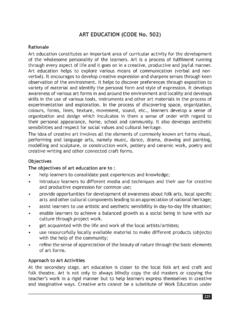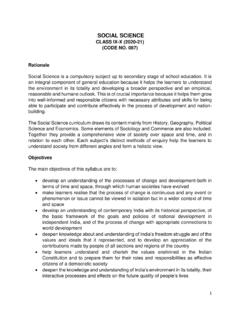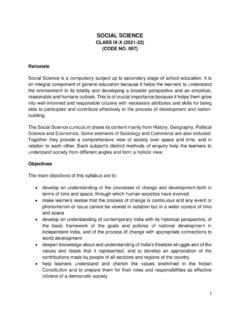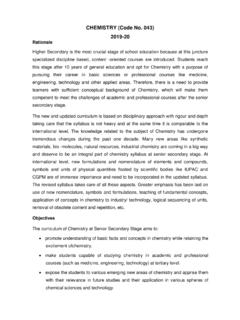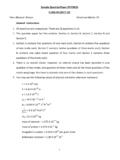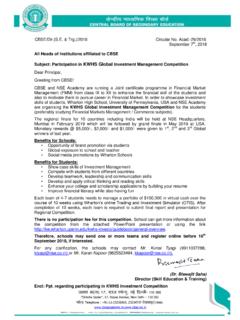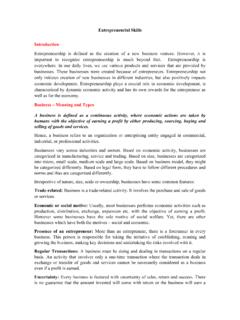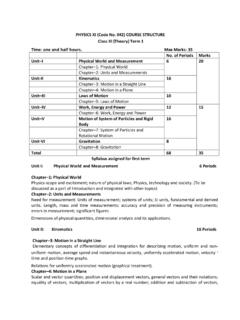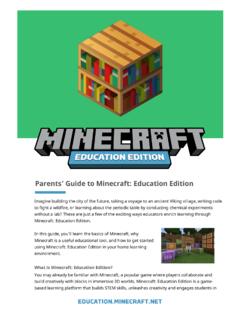Transcription of ARTIFICIAL CURRICULUM - Central Board of Secondary …
1 Curated with support from Intel ARTIFICIALINTELLIGENCECURRICULUMA cknowledgementPatrons: Sh. Ramesh Pokhriyal 'Nishank', Minister of Human Resource Development, Government of India Sh. Dhotre Sanjay Shamrao, Minister of State for Human Resource Development, Government of India Ms. Rina Ray, IAS, Secretary, Department of School Educa on and Literacy, Ministry Human Resource Development, Government of IndiaAdvisory, Editorial and Crea ve Inputs: Ms. Anita Karwal, IAS, Chairperson, Central Board of Secondary Educa on Ms. Shweta Khurana, Director, Corporate Affairs Intel India Guidance and Support: Sh.
2 Anurag Tripathi, IRPS, Secretary, Central Board of Secondary Educa on Dr. Joseph Emmanuel, Director (Academics), Central Board of Secondary Educa on Dr. Biswajit Saha, Director (Skill Educa on & Training), Central Board of Secondary Educa on Value adder, Curator and Co-ordinator: Sh. Ravinder Pal Singh, Joint Secretary, Department of Skill Educa on, Central Board of Secondary Educa onContent Cura on Team: Ms. Sharon E. Kumar, Innova on and Educa on Consultant, Intel AI4 Youth Program. Ms. Ambika Saxena, AI Coach, Intel AI4 Youth Program Ms. Shyda Rana, Senior Faculty, Army Welfare Educa on SocietyAbout the BookAr ficial Intelligence (AI) is being widely recognized to be the power that will fuel the future global digital economy.
3 AI in the past few years has gained geo-strategic importance and a large number of countries are striving hard to stay ahead with their policy ini a ves to get their country ready. India's own AI Strategy iden fies AI as an opportunity and solu on provider for inclusive economic growth and social development. The report also iden fies the importance of skills-based educa on (as opposed to knowledge intensive educa on), and the value of project related work in order to effec vely harness the poten al of AI in a sustainable manner and to make India's next genera on 'AI ready'.
4 As a beginning in this direc on, CBSE has introduced Ar ficial Intelligence as an op onal subject at Class IX from the Session 2019-2020 onwards. To enhance the mul disciplinary approach in teaching learning and also to sensi ze the new genera on, it was decided that Schools may start AI Inspire module of 12 hours at Class VIII itself. CBSE is already offering various Skill subjects at Secondary and Senior Secondary level to upgrade the skills and proficiency of the young genera on and also to provide them awareness to explore various career op ons.
5 At Secondary Level, a Skill subject may be offered as addi onal sixth subject along with the exis ng five compulsory subjects. CBSE acknowledges the ini a ve by Intel India in cura ng this Facilitator Manual, the AI training video and managing the subsequent trainings of trainers on the Ar ficial Intelligence aim is to strive together to make our students future ready and help them work on incorpora ng Ar ficial Intelligence to improve their learning experience. 1 Contents Conceptual Framework Introduction to ARTIFICIAL Intelligence 3 Rationale 4 The Purpose 4 Overview of the AI CURRICULUM 5 Overview and learning Objectives of the AI Program 6 Essential learning Experience from AI 6 Developing Key Competencies for Lifelong learning 6 The AI CURRICULUM School Procedures for AI Implementation 7 AI Implementation Procedures 7 AI Syllabus 8 Unit wise Distribution 8 Assessment 9 Suggestive Assessment Approaches for AI 9 AI CURRICULUM Mapping 10 Interdisciplinary Integration with ARTIFICIAL Intelligence.
6 Class IX 10 AI learning Indicators 11 Translating AI on Ground 13 Creating the Mindset 13 Preparatory Groundwork 13 Facilitating and Feedback 13 Mentoring and Monitoring 13 Unit 1 Excite 14 Introduction to AI 14 Dream Smart Home 16 Activity Game Time 18 Quiz Time: AI Quiz 23 Activity: Letter to future Self 24 Relate 26 Floorplan Activity 26 Creating a Story: Are you a good Storyteller? 30 Purpose 34 Sustainable Development Goals 34 Go Goals: 36 2 Possibilities 40 Group Activity: Research on current AI Trends 41 Poster Making Job Advertisement for 2029!
7 46 AI Ethics 49 Activity Watch the video AI for Good. 49 Balloon Debate 50 Unit 2 AI Project Cycle 53 AI Project Cycle Defined! 56 Problem Scoping 58 Getting Started 58 4Ws Problem Canvas 62 Problem Statement Template 64 Data Acquisition 66 What is Data Acquisition? 67 Data Features 68 Acquiring Data from reliable sources 69 System Maps 70 Data Exploration 74 Let us explore 75 Sketchy Graphs 79 Modelling 82 AI, ML & DL 83 Modelling 85 Rule Based Approach 86 learning Based Approach 87 Decision Tree 88 Do It Yourself! 91 Pixel It 94 Unit 3 Neural Networks 98 Neural Networks Defined 101 Neural Networks Vs Human Nervous System 103 Human Neural Network The Game 104 Co-Curricular Activities 111 Annexure 112 All curated material has been responsibly sourced online or purchased 3 Conceptual Framework Introduction to ARTIFICIAL Intelligence ARTIFICIAL Intelligence has always been a term which intrigues people all over the world.
8 Various organisations have coined their own versions of defining ARTIFICIAL Intelligence. Some of them are mentioned below: Niti Aayog: National Strategy for ARTIFICIAL Intelligence AI refers to the ability of machines to perform cognitive tasks like thinking, perceiving, learning , problem solving and decision making. Initially conceived as a technology that could mimic human intelligence, AI has evolved in ways that far exceed its original conception. With incredible advances made in data collection, processing and computation power, intelligent systems can now be deployed to take over a variety of tasks, enable connectivity and enhance productivity.
9 World Economic Forum ARTIFICIAL intelligence (AI) is the software engine that drives the Fourth Industrial Revolution. Its impact can already be seen in homes, businesses and political processes. In its embodied form of robots, it will soon be driving cars, stocking warehouses and caring for the young and elderly. It holds the promise of solving some of the most pressing issues facing society, but also presents challenges such as inscrutable black box algorithms, unethical use of data and potential job displacement. As rapid advances in machine learning (ML) increase the scope and scale of AI s deployment across all aspects of daily life, and as the technology itself can learn and change on its own, multi-stakeholder collaboration is required to optimize accountability, transparency, privacy and impartiality to create trust.
10 European ARTIFICIAL Intelligence (AI) leadership, the path for an integrated vision AI is not a well-defined technology and no universally agreed definition exists. It is rather a cover term for techniques associated with data analysis and pattern recognition. AI is not a new technology, having existed since the 1950s. While some markets, sectors and individual businesses are more advanced than others, AI is still at a relatively early stage of development, so that the range of potential applications, and the quality of most existing applications, have ample margins left for further development and improvement.
